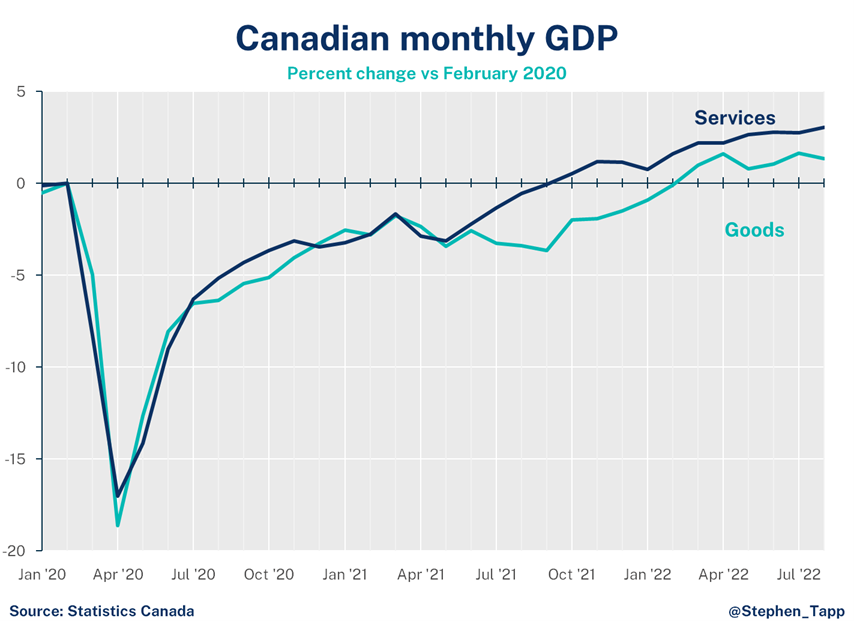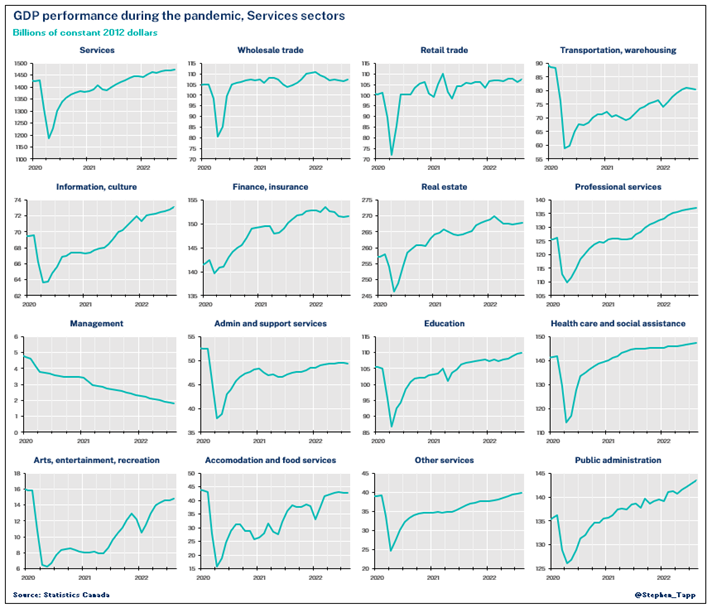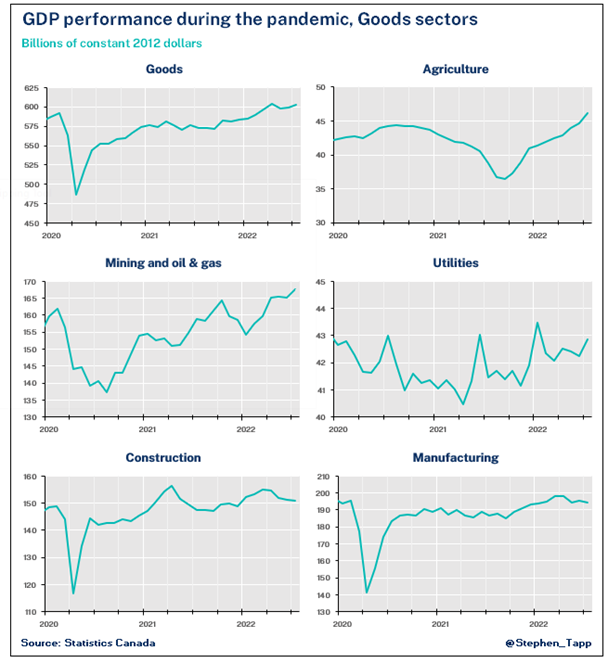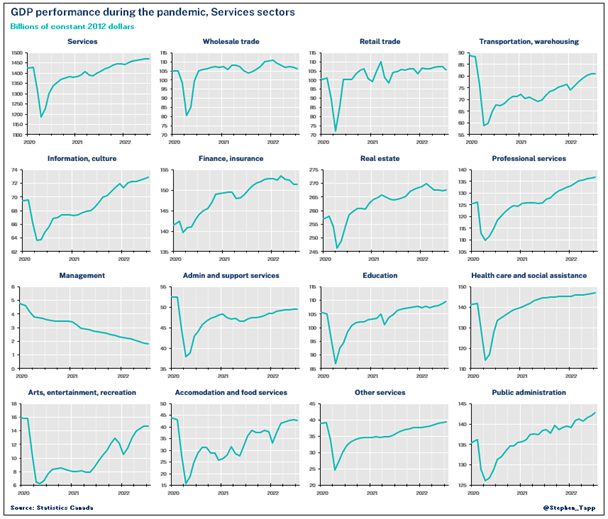Blog /
Canadian Chamber of Commerce Testifies on Port Strike Impact and Supply Chain Stability
Canadian Chamber of Commerce Testifies on Port Strike Impact and Supply Chain Stability
On November 30, 2023, our Deputy Leader and VP of Government Relations, Robin Guy, along with Pascal Chan, Senior Director, Transportation, Infrastructure & Construction, testified before the House of Commons’ Standing Committee on International Trade to discuss the critical impact of the recent strike at the Port of Vancouver.

On November 30, 2023, our Deputy Leader and VP of Government Relations, Robin Guy, along with Pascal Chan, Senior Director, Transportation, Infrastructure & Construction, testified before the House of Commons’ Standing Committee on International Trade to discuss the critical impact of the recent strike at the Port of Vancouver. They emphasized the significance of trade infrastructure for Canada, where two-thirds of every dollar earned relies on moving goods. The summer strike on the West Coast, affecting Vancouver and Prince Rupert, caused major disruptions, impacting sectors nationwide, from agriculture to manufacturing. The strike halted 25% of Canada’s total trade, affecting potash production, machinery repairs, and even causing agricultural goods to rot, contributing to inflation.
They stressed the need for government action to prevent and resolve such strikes promptly, protecting Canada’s credibility as a reliable trading partner, and expressed concern about Bill C-58, which aims to prohibit the use of replacement workers during strikes, potentially destabilizing supply chains. The testimony urged an honest dialogue to address labor challenges effectively while preserving stability and reliability in Canada’s trade operations.
WATCH THE TESTIMONY AND READ THE FULL REMARKS BY ROBIN GUY BELOW.
Good morning, Madame Chair and honourable members.
The Canadian Chamber of Commerce is the country’s largest business association with an active network of over 400 chambers of commerce and boards of trade representing nearly 200,000 businesses of all sizes, in all sectors and regions of our country.
I am joined today by my colleague Pascal Chan, Senior Director, Transportation, Infrastructure and Construction.
As a trading nation, our trade infrastructure matters more to Canada than many other countries around the world. In fact, 2 out of every 3 dollars that Canada makes rely on moving goods. This is significantly higher than the OECD average of just over 50%. When Canadian businesses can’t import or export goods reliably, we undermine our ability to grow our economy.
Our West Coast is Canada’s largest gateway to the world handling over $800-million worth of cargo – from agri-foods and potash, to critical minerals and household necessities – every single day. That accounts for a quarter of Canada’s total trade.
This summer, we saw over 35 days of uncertainty and disruption to our West Coast gateways, including Vancouver and Prince Rupert, that caused major delays for Canadian businesses in virtually every sector across the country.
I’ll repeat that 25 per cent of our trade stopped. This meant Canadian potash had to cut production and sales during the strike causing those who rely on Canada for fertilizer had to look elsewhere to ensure they could continue to grow crops.
This meant that businesses looking for replacement parts to fix machinery were delayed causing production to slow or stop.
It meant that fruits and vegetables that we bring to Canada were left to rot in containers as opposed to being on shelves for consumers to enjoy.
Plain and simple – it meant that goods were going to become more expensive for Canadians and fuel inflation.
I will stress to the Committee that the damage from a strike does not simply take place in the days workers are picketing. Businesses need certainty. They need to know that if they are importing or exporting goods that they will get where they need to go, when they need to be there. If not, suppliers will go elsewhere, and it is not guaranteed that they will come back.
When looking at Canada’s record, many of our trading partners are beginning to question if Canada can reliably get goods to market. We saw this shortly after the West Coast port strike with the St. Lawrence Seaway, and with the uncertainty that is looming at the Port of Montreal.
I must state that the Canadian Chamber respects the right to collective bargaining. We believe sincerely that the best deals are reached at the table. But when negotiations break down and meaningful bargaining is no longer possible, the Canadian business community expects the government to show leadership and act in the best interest of the country.
The Canadian Chamber called on the government to use all of the tools it currently had in its toolbox to prevent a strike and then to solve it.
We applauded the Minister of Labour for directing the senior mediator to recommend terms of settlement to reach a fair deal.
But, unfortunately, we did not see that action until nearly two weeks into the ports strike, when significant damage to the economy and Canada’s reputation had already taken place, and that dragged on for further weeks while the union failed to ratify the agreement.
The review initiated by the Minister of Labour and Seniors under Section 106 of the Canadian Labour Code is a key opportunity to do this – to equip the government with more tools to be able to avoid labour disruptions while protecting public interest.
We need to make sure that the government has the ability to force the two sides together in a form of binding resolution. We can’t have the government waiting on the sidelines for two weeks before action is taken.
Canada’s supply chains are only as strong as their weakest link. Government can’t solve all of our supply chain issues – but it must look to enable policies that will enable trade and strengthen supply chains.
Less than a month ago, the Minister of Labour told Canadians that “our credibility as a trading nation depends on the stable operation of our supply chains. We must do everything we can to preserve that stability.” We couldn’t agree more.
However, the introduction of Bill C-58, which aims to prohibit the use of replacement workers during strikes suggests that the government actually wants to move away from preserving stability. It is in fact, doubling down on Canada being seen as an unreliable and unstable trading partner.
We need our leaders to engage in an honest dialogue that will provide our government with the tools it needs to address our labour challenges, while allowing employers and employees to bargain the way they should. For the sake of our economy, I would urge all parties to vote against this legislation.
Thank you for your time. I look forward to answering your questions.
Related News

Canadian Chamber Appears Before House of Commons Standing Committee on International Trade

Top Hiring and Training Government Funding Programs

Canadian Business Leaders Celebrated at Vancouver Awards Dinner
Blog /
Canadian Chamber of Commerce Appears Before Standing Committee on Natural Resources
Canadian Chamber of Commerce Appears Before Standing Committee on Natural Resources
On October 23, 2023, the Canadian Chamber's Matthew Holmes and Bryan Detchou, appeared before the House of Commons Standing Committee on Natural Resources, to discuss Canada's clean energy transition.

On October 23, 2023, the Canadian Chamber’s Senior Vice President of Policy and Government Relations, Matthew Holmes, and Senior Director of Natural Resources, Environment and Sustainability, Bryan Detchou, appeared before the House of Commons Standing Committee on Natural Resources, to discuss Canada’s clean energy transition. They focused on what Canadian businesses need from the federal government in order to help Canada achieve its economic and environmental ambitions and position our nation as a leader in the global transition economy.
The full letter and video recording can both be found below.
Mr. Chair, Honourable Members: it’s a pleasure to join you today for this discussion.
My colleague and I are here on behalf of the Canadian Chamber of Commerce to speak to the steps necessary for Canada to meet the challenges and opportunities presented by the broader North American energy transformation. Getting the clean energy transition right is important to our members because not only do we represent the sectors and businesses most involved in this transformation, but also the communities across this country which they support.
The Canadian Chamber of Commerce represents 200,000 Canadian businesses through more than 400 local, provincial, and territorial chambers and boards of trade, and over 120 trade associations. We represent members in every sector of the economy, all sizes of business, across all regions of the country.
First, let me emphasize that the Canadian Chamber and our members recognize the paramount importance of addressing climate change and meeting our net zero goals. Canadian business of all sizes from coast to coast to coast are committed to playing their part in the collective effort to combat climate change.
With that said, our remarks will focus on what Canadian businesses need from the federal government to help Canada achieve its economic and environmental ambitions and position our nation as a leader in the global transition economy. Candidly, what businesses need can be summarized in four words: ambition, clarity, predictability, and efficacy.
I will now share the time with my colleague, Bryan Detchou:
Le Canada ne manque pas d’ambition. Nous reconnaissons et saluons l’engagement résolu du gouvernement à mener des initiatives mondiales visant à lutter contre le changement climatique. Cependant, le Canada peut avoir toute l’ambition du monde, seule l’action fait avancer les choses. Malheureusement, le Canada a acquis la réputation d’être un pays où les grands projets ne peuvent être réalisés. Nous devons apprendre que la collaboration avec le secteur privé est le seul moyen d’atteindre nos objectifs communs en matière d’émissions nettes zéro.
La transition mondiale vers la consommation nette zéro est en bonne voie. La capacité du Canada à être compétitif et à réussir exige de l’adaptabilité, de la rapidité et une coordination efficace de la part des gouvernements et de l’industrie. Les entreprises canadiennes auront du mal à suivre cette transition si elles ne disposent pas à temps de l’infrastructure, des cadres réglementaires et des programmes de financement nécessaires.
Right now, Canada’s lack of clarity, predictability, and efficacy in its approach to environmental policies represents the foremost challenge in achieving the nation’s net-zero commitments. These issues impede the ability of businesses to make informed decisions, plan for the long term, and allocate resources effectively. They also discourage the foreign direct investment and innovation our economy needs.
The urgency of 2030 and 2050 net-zero targets requires that federal government prioritize:
- Removing barriers that compromise competitiveness, delay project approvals, and place redundant or overly onerous reporting requirements on businesses;
- Reducing permitting timelines to speed up the pace of investment and development of major projects;
- Accelerating the implementation of incentives for clean technology deployment and adoption in Canada through investment tax credits, strategic finance, and targeted programming
- Incentivize partnerships with Indigenous communities that advance decarbonization projects and support economic reconciliation.
- Establishing a modernized, efficient regulatory framework that responds to the needs of industry and respects the jurisdictions of both the federal government and the provinces.
- Acknowledging regional differences, as geographic, economic, and demographic diversity necessitates different policies, practices, and investments.
Lastly, I understand the Committee continues to examine the competitive challenges the United States Inflation Reduction Act poses for Canada in attracting investment for the domestic net-zero economy. While Canada cannot directly rival the U.S. in terms of financial resources, nonetheless, direct financial support, investments, and incentives remain an indispensable part of the policy mix. What Canada must also strive for is to turn its regulatory framework and operational efficiency into a competitive strength that will allow us to spearhead the North American energy transformation.
En procédant à ces ajustements, le gouvernement canadien peut rétablir la confiance dont les entreprises canadiennes ont besoin pour prendre des décisions d’investissement à long terme, introduire des technologies net-zéro innovantes et attirer des investissements indispensables dans notre pays, accélérant ainsi les progrès du pays dans la réalisation de nos ambitions net-zéro.
Je vous remercie de votre attention,
Matthew Holmes
Senior Vice President, Policy and Government Relations
Canadian Chamber of Commerce
Bryan Detchou
Senior Director, Natural Resources, Environment and Sustainability
Canadian Chamber of Commerce
Related News

The Canadian Chamber Appears Before Senate National Finance Committee on Bill C-59

2022 Q3 Canadian Survey on Business Conditions: Inflation is the top issue. Labour pains intensifying, but price pressures and supply chains issues are improving

Canadian Chamber Appears before Standing Committee on Public Safety and National Security
Blog /
Celebrating Success: Highlights from the Canadian Business Leader Awards
Celebrating Success: Highlights from the Canadian Business Leader Awards
Toronto, ON | September 28, 2023 On the evening of September 28th, we had the privilege of hosting a remarkable...

Toronto, ON | September 28, 2023
On the evening of September 28th, we had the privilege of hosting a remarkable reception dedicated to celebrating the exceptional contributions of two outstanding business luminaries, Heather Chalmers and Peter Gilgan. The evening brimmed with energy, inspiration, and opportunities for networking, all set against a backdrop of Canadian business success. We applaud our esteemed honourees for their unwavering dedication to advancing Canada’s business landscape, championing innovation sustainability, and economic growth.
Both our honourees, Heather Chalmers and Peter Gilgan, share the Canadian Chamber’s values of excellence, innovation, collaboration and leadership and their long list of achievements inspires a sense ofoptimism and pride in the Canadian business community and its commitment to creating a brighter future for Canada.
Perrin Beatty, President and CEO, Canadian Chamber of Commerce
Heather Chalmers, Canadian Business Leader of the Year Honouree

Peter Gilgan, Canadian Business Leader Lifetime Achievement Honouree

Click here to read more about our recipients.
To see a list of all our past recipients and to find out more details on our 2023 honorees please visit our Canadian Business Leader Awards page.
We want to thank all the staff at the Ritz-Carlton and all our event sponsors who helped to make the night a great success.

Related News

Canadian Chamber of Commerce Testifies on Port Strike Impact and Supply Chain Stability

Time to put reports into action, Chamber tells House Agriculture Committee

Canadian Chamber Appears Before House of Commons Standing Committee on International Trade
Blog /
The Outstanding Honourees of the Canadian Business Leader Awards
The Outstanding Honourees of the Canadian Business Leader Awards
Calgary, AB | September 14, 2023 On the evening of September 14, we hosted a special reception honouring two outstanding...

Calgary, AB | September 14, 2023
On the evening of September 14, we hosted a special reception honouring two outstanding business leaders from Calgary, Susannah Pierce and Al Monaco. The evening was filled with excitement, inspiration, and networking, as well as some great food and entertainment. Our honourees’ commitment to the advancement of business in Canada is truly commendable, and we commend them on promoting innovation, sustainability and growth within our nation’s economy.
Congratulations to Susannah Pierce, Canadian Business Leader of the Year Honouree

Congratulations to Al Monaco, Canadian Business Leader Lifetime Achievement Honouree

Thank you so much Al and Susannah for the work you have done in the Canadian business community. We have all benefited from your exceptional leadership.
Candace Laing, Chair of the Board, Canadian Chamber of Commerce

A special performance from Graham Rowan and his Indigenous dance troupe was an honour to watch and a spectacular welcome to Calgary.
To see a list of all our past recipients and to find out more details on our 2023 honorees please visit our Canadian Business Leader Awards page.
We want to thank all the staff at the Westin Calgary and all our event sponsors who helped to make the night a great success.

Related News

MDR: What Is It? And Why Your Business Needs This Cyber Security Protection?

Canadian Chamber of Commerce Appears Before Standing Committee on Natural Resources

Canadian Chamber Appears before Standing Committee on Public Safety and National Security
Blog /
Submission for the Pre-Budget Consultations in Advance of the Upcoming Federal Budget
Submission for the Pre-Budget Consultations in Advance of the Upcoming Federal Budget
The Canadian Chamber of Commerce, on behalf of our roader membership of 200,000 Canadian businesses, has submitted our pre-budget recommendations to the federal government.

Introduction
Canada’s competitiveness is slipping. As Members of this Committee know, we must achieve much stronger growth if we are to maintain our standard of living and continue to provide the services Canadians require.
The Canadian Chamber continues to urge the government to focus on growth driven by the private sector: many of the measures included in our submission, including regulatory reform, and dismantling internal barriers, will cost little or nothing, but will generate future wealth and investment. Budget 2024 is the opportunity to implement a decisive strategy to attract the investment needed for strong, sustainable growth and a successful net-zero transition.
In the aftermath of the pandemic, our international competitors continue to outpace us, but our opportunities are clear. Geopolitical conditions have introduced insecurity and disrupted the rule of law and traditional trading relationships. While Canada is also exposed to this problem, we are unique among free societies in our potential to underwrite global economic security through our abundant natural resources.
We now have an opportunity to show the world we can, quite literally, deliver the goods.
The Canadian Chamber of Commerce’s pre-budget submission has been shaped by our member councils and committees, on behalf of our broader membership of 200,000 businesses of every size, from all regions and economic sectors of Canada.
Additionally, the Canadian Chamber of Commerce is seeking the government’s ongoing and expanded support for the Business Data Lab (BDL). Looking ahead, business survival and success will require continued access to the BDL’s user-friendly tools and insights, so businesses can be agile in response to rapidly shifting economic trends. With funding set to expire in March 2024, we are requesting a three-year expansion of the BDL’s successful partnership with Statistics Canada as it builds toward self-sufficiency. This extension would not only preserve the valuable business data assets already curated, but also maintain and expand the impressive suite of innovative BDL outputs and real-time data made freely available to Canadian businesses, municipalities, academic researchers, and community groups.
The Canadian Chamber of Commerce is eager to partner with government on the strategy that will allow us to respond to this moment. Given the headwinds we face, collaboration between policymakers and the business community is more critical than ever before.
Build Trade-Enhancing Infrastructure
Clear priorities on trade infrastructure projects that yield measurable economic returns are critical. Government can work with provinces, the private sector, communities, and Indigenous peoples to resolve supply chain challenges to enable the Canadian exports the world needs.
- Commit to long-term investment through a Canada Trade Infrastructure Plan. Canada must build and maintain trade infrastructure that reliably and efficiently transports goods to and from market. Domestic and international trade corridors should solidify supply chains and establish Canada as a reliable business partner.
- Expand abilities to head off preventable threats to supply chains. Recurring labour disruptions continue to inflict damage to Canada’s economy and reputation. Government should consider providing new dispute resolution tools, including the authority to the federal cabinet to compel binding arbitration for the resolution of a labour dispute in sectors that are essential to Canada’s supply chains, including railways and ports.
- Abandon introducing Anti-Replacement Worker Legislation. Any actions that introduce more volatility and disruption to supply chain processes will only raise costs on Canadians and businesses, and further undermine our trading relationships.
- Act to reduce interprovincial trade barriers by establishing a public registry. A public registry will raise awareness of barriers to inter-provincial trade and encourage governments to justify or eliminate them.
Ease the Burden of Doing Business
Regulators and businesses must work together to prevent undermining Canada’s economic growth and competitiveness. To avoid losing the next generation of talent and innovation to competing nations, government must avoid imposing new business taxes that further drive away investment.
- Launch a comprehensive independent review of the tax system. Canada must reform the tax system to make it simpler and more fair.
- Accelerate regulatory modernization. Acting to modernize our regulatory framework can improve environmental, social and economic protections while increasing investment, growth and jobs.
- Add an economic and competitiveness mandate for regulators. An economic mandate for regulators would encourage manageable regulations that support economic growth and take into account our competitiveness in the global marketplace.
- Ensure regulatory alignment. Government must look to ease the regulatory burden facing Canadian business, and work with industry and our international trading partners to ensure regulatory efficiency and alignment.
- Defer implementation of Pillar 2 of the OECD tax deal in Canada. Consensus and coordination with our primary trading partners, the U.S. and the EU, is essential for achieving a successful path forward.
- Abandon the Digital Services Tax. Current legislation imposes complex retroactivity, invites trade retaliation, and risks doubly taxing revenue.
- Extend the Accelerated investment incentive. Postponing the 2024 phase-out period and 2027 end date will promote investment in productive assets.
- Align SR&ED tax credit criteria with the ITA. Using more restrictive criteria than established by the Income Tax Act for Scientific Research and Experimental Development tax credits stymies business investment and innovation in software, manufacturing, and construction.
- Eliminate or amend the tax on share buybacks. If enacted, it should protect Canadian SMEs by including an exemption threshold and be limited to instances when public companies acquire their own shares on the market for cancellation.
- Eliminate notifiable and reportable transaction reporting rules that adversely affect compliant taxpayers. As currently drafted, these rules can penalize taxpayers when an advisor or promoter fails to comply with reporting obligations, even if the taxpayer has properly reported.
- Preserve the spirit of Bill C-208 provisions for family business transfers. Consulting Canadian businesses to preserve legislative provisions passed by Parliament would give businesses certainly for tax compliance.
- Reconsider annual, automatic indexing of beer, wine, and spirits excise duties. Current legislation is too rigid and does not allow Parliament to consider market or operating environment changes when imposing new taxes.
Facilitate the Transition to Net-Zero
A plan is needed to encourage capital investment that will make Canada a global leader in sustainable finance, while producing and exporting sustainably produced energy, carbon dioxide-removal technologies, clean fuels, critical minerals, and finished goods.
- Increase funding for Indigenous participation in natural resource development. Funding should be directed to Indigenous-led environmental assessments, training and skills development programs, and community consultation.
- Maximize the impact of existing flow-through share tax credits. Relax the time limit for making qualifying expenditures, especially where regulatory delays prevent the company from spending in an allotted time frame, and make those costs eligible for the “look-back” rule.
- Lower financing costs to put mines into production. Incorporating critical mineral pre-production costs into the new Critical Mineral Exploration Tax Credit would spur production.
- Encourage investment in currently uneconomic minerals. Where there is limited interest in private investment, the government should assess potential benefits of support for supply chain resiliency or strategic value, including cases in which global players have significant command of global supply or pricing dynamics.
- Develop a standard definition for “net-zero aligned investment.” Include emission reduction estimates alongside policies, and support the work of the Sustainable Finance Action Council, particularly its transition taxonomy project.
Enable an Innovative Economy
Canadian businesses are well-placed to lead in high-growth sectors, but to maintain this competitive edge, we must capitalize on our advantages in Artificial Intelligence (AI), cybersecurity, and digital health.
- Protect critical infrastructure, supply chains and businesses from cyber threats. Investment in IT and operational technology security will help critical infrastructure operators of all sizes develop and deploy prevention-first cybersecurity strategies.
- Modernize research and development programs. Help companies undertake high-risk research where near-term returns on investment and commercialization are absent.
- Use public sector procurement to stimulate cybersecurity innovation in Canada. Make government technology procurement practices more agile, challenge-based, and outcome-driven.
- Ensure robust intellectual property protection of innovative products. Reasonable and reliable IP protections give innovators the confidence to invest time and significant resources into R&D that spans over many years.
- Prioritize the allocation of spectrum through measures such as increasing the quantity of spectrum available and subsidizing rural deployment. This is important for Canadians across the country to access wireless services and benefit from deployment of 5G networks, utilize the power of the Internet of Things (IoT) and AI, and for Canadian businesses to remain globally competitive.
- Strengthen investment in agriculture. Partner with businesses on research, product development and the commercialization of the agri-food sector, while developing policy mechanisms and supports to incentivize private-sector research and development investment.
- Encourage value added agricultural processing. Increased capital investment in agricultural processing would help Canada meet global food demand, while promoting value-added economic activity in commodities bound for export.
- Create a SME Cyber Defence Fund. Redirect funding from lower-priority government spending so Canada can help SMEs improve their cyber resilience and close the cybersecurity investment gap.
- Expand the Business Data Labs’ partnership with Statistics Canada by three years. With funding set to expire in March 2024, this extension would preserve valuable business data assets, while maintaining and expanding the impressive suite of innovative BDL outputs and real-time data made freely available to Canadian businesses, municipalities, academic researchers, and community groups.
Attract and Retain Talent
Attracting and retaining top talent while increasing productivity is vital to Canadian businesses. However, many sectors struggle to find and retain the talent needed to grow.
- Continue to decentralize the immigration selection process and support local solutions built by communities to address community workforce needs. Collaborate more closely with provincial, territorial and municipal governments, and with the private sector, to better understand labour market needs across the country.
- Develop strategic, skills-based immigration programs aligned with regional labour needs. These can be leveraged to address gaps in the workforce and should be complemented by supports addressing barriers to hiring highly skilled foreign talent, enhancements to the Temporary Foreign Worker Program, and a pathway to permanent residency for agriculture and food workers.
- Expedite and reduce the complexity of foreign qualification recognition. Accelerated progress on mutual recognition across Canada is needed for qualified newcomers to Canada to be able to contribute to the Canadian economy.
- Collaborate with provinces/territories to enable enhanced upskilling and reskilling to meet labour market needs. Providing Canadians with flexible, accessible, navigable education and skills development options to foster a culture of lifelong learning to create talent pipelines trough targeted matchmaking programs.
Lead in Life Sciences
COVID-19 made the value of the life sciences sector clear, highlighting Canada’s shortcomings in domestic manufacturing and exposing a vital requirement to get Canadians the medicines they need, when they need them.
- Improve regulatory agility in life sciences and medical review processes. Focus on flexible, timely licensing pathways that incorporate patient engagement, and launch an agile health procurement implementation process to pilot and deploy promising products and technologies increasing health system security and driving improved medical outcomes.
- Launch life sciences innovation support programs. Incorporate the renewal of existing envelopes and add nimble streams encouraging companies to undertake higher-risk ventures.
- Include the life sciences innovation ecosystem in deployment of the
Pan-Canadian Health Data Strategy. Integrate real-world evidence to support decision making and accelerate adoption of innovation. - Ensure appropriate scope for National Pharmacare. Build on, rather than displace, the important role played by private payers and employers, while respecting the jurisdiction of provinces and territories.
- Integrate the life sciences sector into global supply chains. Foster resilience and competitiveness by making Canada a part of the global solution.
Related News

Time to put reports into action, Chamber tells House Agriculture Committee

Celebrating Success: Highlights from the Canadian Business Leader Awards

Five Ways to Protect Your Business Against an Evolving Threat Landscape
Blog /
Canadian Business Leaders Celebrated at Vancouver Awards Dinner
Canadian Business Leaders Celebrated at Vancouver Awards Dinner
On Thursday, June 1 we hosted a celebratory evening in Vancouver for two of Canada’s most influential business leaders, Ryan...

On Thursday, June 1 we hosted a celebratory evening in Vancouver for two of Canada’s most influential business leaders, Ryan Beedie and Karen Flavelle. The evening was filled with great music, dancing and some sweet treats from Purdys Chocolatier.
Ryan Beedie, Canadian Business Leader of the Year Honouree

Ryan Beedie, the 2023 Canadian Business Leader of the Year honouree. He was joined last evening by his wife Cindy and his son Trevor.
Karen Flavelle, Canadian Business Leader Lifetime Achievement Honouree

Karen Flavelle, the 2023 Canadian Business Leader Lifetime Achievement Honouree. She was joined last evening by her husband Jamie, her son Scott and her father, Charles.
“I can’t tell you how wonderful it feels to be here celebrating the best of our business community”
Perrin Beatty, CEO, Canadian Chamber of Commerce
Honorees and guests were treated to special performance by world-renowned jazz musician and singer Brian Newman. Splitting his time between touring with Lady Gaga and Tony Bennett and leading his own quartet with his crooner jazz revival and signature expert trumpeting, Newman made our attendees feel as if they are a part of his performance.


To see a list of all our past recipients and to find out more details on our 2023 honorees please visit our Canadian Business Leader Awards page.
We want to thank all the staff at the Fairmont Pacific Rim and all our event sponsors who helped to make the night a great success.
Related News

What We Heard: “Economic Reconciliation and Indigenous Entrepreneurship” Inclusive Growth Dialogue

Canadian Chamber of Commerce Appears Before Standing Committee on Natural Resources

Nice Guys Finish First: Empowering Canadian Business with Negotiation Strategies
Blog /
Canadian Chamber to House of Commons Standing Committee on Transport, Infrastructure and Communities: We need to see long term investment in Canada’s trade infrastructure.
Canadian Chamber to House of Commons Standing Committee on Transport, Infrastructure and Communities: We need to see long term investment in Canada’s trade infrastructure.
In his appearance before the Standing Committee on Transport, Infrastructure and Communities, Robin Guy, Vice President & Deputy Leader, Government...

In his appearance before the Standing Committee on Transport, Infrastructure and Communities, Robin Guy, Vice President & Deputy Leader, Government Relations at the Canadian Chamber of Commerce, highlighted the significance of large port infrastructure expansion projects for Canada’s trade and economic growth.
As a trading nation heavily reliant on moving goods, investing in trade infrastructure is crucial to ensure efficient movement of essential goods and maintain competitiveness. Guy emphasized the need for long-term investment in trade infrastructure, including marine ports, railways, airports, and road systems, to support reliable supply chains and address challenges both now and in the future. He stressed the importance of government leadership in infrastructure investment, the need for funding and strategic vision for trade corridors, and the acceleration of regulatory modernization to attract investment and foster economic opportunities.
His full remarks are available below.
“Good morning, Mr. Chair and honourable members,
It is a pleasure to be appearing again before this Standing Committee. On behalf of the Canadian Chamber of Commerce, I would like to thank you for the opportunity to provide comment on the Committee’s study on ‘Large Port Infrastructure Expansion Projects in Canada.’
The Canadian Chamber of Commerce is the country’s largest business association with an active network of over 400 chambers of commerce and boards of trade representing nearly 200,000 businesses of all sizes, in all sectors and regions of our country.
As a trading nation, it is safe to say that trade infrastructure matters more to Canada than many other countries around the world. In fact, two out of every three dollars that Canada makes rely on moving goods. This is significantly higher than the OECD average of just over 50%.
Simply put, Canada needs to continue invest in trade infrastructure, including large port infrastructure expansion projects. Without focusing on these projects, we will not be able to get goods like food, fuel, fertilizer and critical minerals to market. Without focusing on these projects, we risk becoming less competitive. And without focusing on these projects we risk not being able to grow our economy.
Canada’s supply chains are only as strong as our weakest link. While we are seeing improvements, supply chain issues remain a key obstacle to growth for business. According to the most recent Statistics Canada Canadian Survey on Business Conditions, a quarter of business are still identifying supply chain challenges as a key concern, and one that they expect to persist further into 2023.
As we eagerly await Budget 2023 to be tabled by the Deputy Prime Minister and Minister of Finance later today, the message the business community is looking to hear is related to economic growth. Enhancing our trade infrastructure is a key ingredient that will support growing our economy.
In the time remaining, please allow me to dig into this a bit further.
If Canada is looking to grow our economy, we need to see long term investment in Canada’s trade infrastructure, including not just our marine ports as they are only one part of the chain, but also our railways, airports, and road systems supporting it all. Businesses need to be able to get their goods to market efficiently, and reliably. We can’t just simply look to address the needs of today, but of the challenges and opportunities that we see 20 and 30 years from now.
There is a need for funding for projects that support redundancy in critical infrastructure to reduce risk of critical failures to supply chains – for example building new pipelines, bridges, railroads, marine ports and airports. Some of these investments include investing in projects that will expand rail in highly congested areas; increasing bridge capacity; and increasing industrial lands around airports and ports to sustain trade growth.
While government isn’t solely responsible for infrastructure investment, its leadership is critical. A federal commitment to major, strategic, long-term investments is key to building Canada’s trade infrastructure.
The Government’s National Trade Corridors Fund is a positive step forward. While it is supporting worthwhile projects in the key areas above, the government must work to increase the speed at which projects receive funding. Too often, projects are stalled due to government inefficiencies. It must work with business on ensuring transparency for projects and by continuing to demonstrate how funding is helping address supply chain challenges of both today and tomorrow.
Another critical step forward is developing a vision for Canada’s trade corridors.
Trade corridors are key to this transportation of goods, and the government must look to work with business to develop new gateway strategies, including those for Western, St. Lawrence and Arctic Gateways.
Each corridor strategy would lay out how government would work with provinces, the private sector, communities and Indigenous peoples to identify capacity challenges facing our corridor transportation systems and develop a pipeline of actionable solutions.
Lastly, we need government commitment to accelerating its regulatory modernization agenda. Regulatory effectiveness is integral to a competitive environment and requires regulating smarter to attract new economic opportunities to Canada.
Regulatory uncertainty and changing expectations in the regulatory process are a poison pill to those looking to invest billions of dollars developing new pipelines, new mines and other large-scale nation-building infrastructure projects. We need predictable timelines to encourage capital investment. It can’t take a decade to approve infrastructure projects. In this sense, streamlining the regulatory process and adopting strict timelines for approving major infrastructure projects is essential — and long overdue.
Thank you again for the opportunity to address the Committee and I look forward to your questions.”
Related News

Canadian Chamber Appears Before OGGO Committee on Government Operations and Estimates

Canadian Chamber of Commerce Testifies on Port Strike Impact and Supply Chain Stability

Nice Guys Finish First: Empowering Canadian Business with Negotiation Strategies
Blog /
Canadian GDP for August: It’s not all bad news
Canadian GDP for August: It’s not all bad news
Canada’s real GDP grew by 0.1% in August, led by gains in services, with the advanced estimate for September showing...



Canada’s real GDP grew by 0.1% in August, led by gains in services, with the advanced estimate for September showing yet another modest gain (0.1%). Taken together, real GDP is growing at an annualized pace of 1.6% in 2022Q3. This is roughly half the pace of the previous quarter, which shows that Canada’s economy is clearly slowing down in the second half of the year. However, despite all the recession worries, growth remains in positive territory for now, although we expect things to be even weaker in the fourth quarter.
Stephen Tapp, Chief Economist, Canadian Chamber of Commerce
KEY TAKEAWAYS
- Canada’s real gross domestic product (GDP) grew by 0.1% in August, led by services sectors. This result was a slight improvement on the initial advanced estimate for essentially flat growth.
- StatCan’s advanced estimate for September shows another modest increase of 0.1%. These estimates put real GDP growth on pace for an annualized 1.6% in 2022Q3. This pace is inline with the Bank of Canada’s forecast released earlier this week. These numbers show that overall economic growth in Canada is slowing in the second half of the year, and growth expected to be even slower in the fourth quarter.
- Output rose in August in 14 of 20 sectors. Services sectorsled the wayrising by 0.3%,while goods were down 0.3% due to declines in manufacturing, oil and gas extraction, and construction.
- The biggest movers on the month were:
- Agriculture (+3.9%) was led by an increased crop production, as wheat and other grains have benefitted from improved growing conditions in Western Canada this summer.
- Utilities (1.5%) rose thanks to gains in electric power generation and natural gas distribution.
- Retail trade (+1.2%) and wholesale trade (+0.9%) both performed well.
- Construction (-0.7%) fell for the fifth month in a row. All components have weakened, from engineering to residential, non-residential, and repairs.
- Manufacturing (-0.8%) had its fourth decline in five months falling to the lowest output level since January 2022.
- Agriculture (+3.9%) was led by an increased crop production, as wheat and other grains have benefitted from improved growing conditions in Western Canada this summer.
SUMMARY TABLES





Related News

Canadian Chamber Appears Before OGGO Committee on Government Operations and Estimates

Canadian Chamber of Commerce Appears Before Standing Committee on Natural Resources

Nice Guys Finish First: Empowering Canadian Business with Negotiation Strategies
Blog /
MDR: What Is It? And Why Your Business Needs This Cyber Security Protection?
MDR: What Is It? And Why Your Business Needs This Cyber Security Protection?
This featured blog was provided by Calvin Engen, F12.net CTO, CISSP. October is Cyber Security Awareness Month, so if you’re...

This featured blog was provided by Calvin Engen, F12.net CTO, CISSP.
October is Cyber Security Awareness Month, so if you’re a business owner or leader, you may be exploring ways to enhance your organization’s cyber security. As you do, you are bound to run into scores of perplexing acronyms. One that is gaining steam in the cyber security space is MDR. But what is it? Who needs it? And how does it differ from all the other similar sounding acronyms?
MDR is a simple and effective IT shield that every SME should have.
Managed detection and response (MDR) is a cybersecurity service that performs “threat hunting” within a corporate environment. It rapidly identifies and limits the impact of threats without requiring additional or specialized staffing within a business—music to the ears of hiring managers everywhere during this unprecedented staffing shortage. MDR is an essential component required to protect a business from cyber threats.
Detection and response are essential.
If you see value in smoke detectors, fire alarms and fire departments, you’re already a believer in detection and response. After all, it is not enough to put all the focus on fire prevention and insurance recovery. The same applies to your cyber security only, since every business is globally connected, there are multitudes of cyber arsons afoot in your digital neighbourhood.
Without MDR it takes, on average, 110 days for a security breach to be detected.
That means a cybercriminal has over three months to quietly move around within the network, lifting data and intellectual property and preparing for a ransomware attack. Once the ransomware attack occurs, a company goes into disaster mode, implementing their incident response plan—but they’re scrambling, not knowing how the adversary gained access, what they were doing within the network and what information they exfiltrated.
MDR reduces the time of detection to a matter of days, hours or even minutes.
The surveillance service is constantly threat hunting, searching for the breadcrumbs a hacker will leave in their wake, following them and catching up before they’ve had a chance to extract any company information or damage valuable data.
EDR, EPDR, TDR, MDR, FDR?
OK, the last one is a former president. But the others are all real security acronyms, which is confusing. Here is what you need to know, EDR, EPDR and TDR are automated tools deployed to protect endpoints. MDR is a service that combines technology and human intelligence to hunt for and respond to cyber threats in real time.
A good cyber protection plan is made up of several layers.
Leadership. Business leaders need to decide how to best protect their digital assets. Identify those assets (known in the IT world as the “crown jewels”) and become educated on how to adequately secure and protect them. This includes developing and enforcing policies impacting data access, storage, retention and destruction.
Awareness and training. Train employees to identify a malicious attack, they are your “human firewall”. It’s important to educate your team in a meaningful and interesting way, otherwise, there’s a good chance of it going in one ear and out the other. Follow-up training with varied testing so they can apply their knowledge. This should not be an annual activity; refresh everyone’s muscle memory at least once a month.
Cyber hygiene. Businesses must manage their risks with frequent updates and validation to ensure systems are patched, tools are deployed, passwords are rotated, policies are actioned, and vulnerabilities are managed. An experienced managed security service provider (MSSP) will offer services to keep a business’s cyber hygiene squeaky clean.
The MDR layer. With all the previous layers established, a company is well set up to prevent a breach of their organization—but that doesn’t mean it will never happen. It would be illogical to build a house, but never install a fire detector, right? MDR is the fire detector and the fire department, putting out the fire before there’s significant damage.
Recovery. Even with all the above, you still need insurance. That means backups, disaster recovery plans, and, yes, cyber security insurance. Just as you cannot get affordable fire insurance coverage without adequate fire protection, detection, and proximity to response services, you’ll find you cannot obtain affordable cyber insurance without all the other layers.
A cyber security consultant can perform a security assessment to identify and prioritize a company’s gaps. This is useful because often, a company is unclear on which security investments will have the biggest impact. An assessment will identify critical assets, pinpoint any weaknesses in the organization’s defence, and recommend measures to augment existing layers of protection so that a company’s private data stays private. And isn’t that the kind of cybersecurity your business actually needs?
Looking to learn more about whether MDR is right for your company? Feel free to reach out to Calvin Engen, F12.net’s CTO, at cengen@f12.net.
Related News

Canadian Chamber to House of Commons Standing Committee on Transport, Infrastructure and Communities: We need to see long term investment in Canada’s trade infrastructure.

Celebrating Success: Highlights from the Canadian Business Leader Awards

What We Heard at The State of Small Businesses in Canada Virtual Event
Blog /
Canadian GDP for July: Defying expectations, a stronger start to the third quarter than anticipated, but a slowdown remains in clear sight
Canadian GDP for July: Defying expectations, a stronger start to the third quarter than anticipated, but a slowdown remains in clear sight
The writing has been on the wall for Canada’s real GDP as slowdown has been underway in the third quarter with falling housing prices and three consecutive months of job losses. July’s data gave Canadians slight reprieve with a surprising real GDP edging growth of 0.1%.



The writing has been on the wall for Canada’s real GDP as slowdown has been underway in the third quarter with falling housing prices and three consecutive months of job losses. July’s data gave Canadians slight reprieve with a surprising real GDP edging growth of 0.1%. Still, with consumption for in-person services moderating after months of pent-up demand, inflation is placing consumers and producers in the line of fire. Canadians all around should brace for impact in the coming half –interest rate hikes are likely to continue in tandem with sustained slowdown from here on out for a while.
Marwa Abdou, Senior Research Director, Canadian Chamber of Commerce
KEY TAKEAWAYS
- Canada’s real gross domestic product (GDP) increased 0.1% in July, powered by growth in natural resources (agriculture and oil and gas) and the public sector. This headline result outperformed the previous advanced estimate of -0.1%.
- StatsCan’s advanced estimate for August shows essentially no change. Assuming no change for the rest of the quarter, puts real GDP growth on pace for an annualized 0.7% in 2022Q3 — much slower than in the first half of the year, and weaker the Bank of Canada’s most recent forecast (2.0%).
- Output increased in 11 of 20 sectors. Goods-producing sectors led the way,rising by 0.5%. Consumption for in-person services is moderating after months of pent-up demand, and services fell by 0.1% on the month.
- The biggest movers in July were:
- Agriculture, farming, and forestry had the highest sector growth(3.2%) driven by crop production. This rebound, particularly, in wheat and grain production comes from an improved harvest, thanks to improved weather conditions and strengthening demand.
- Mining, quarrying oil and gas alsoenjoyed gains (1.9%), following two months of declines last quarter. This was partly related to oil sands facilities maintenance that had constrained production, amid strong demand.
- Retail Trade declined(-1.9%) as food and beverage (-1.8%) as well as gas continued to fall prey to soaring prices and ‘normalized’ demand.
- Accommodation and food services declined for the first time in two quarters (-1.0%).
- Manufacturing also contracted (-0.5%) — its third decline in four months — alongside Wholesale trade’s (-0.7%) fifth decline since the start of the year.




For more economic analysis and insights, visit our Business Data Lab.
Related News

Canadian Chamber Appears before Standing Committee on Public Safety and National Security

Canadian Chamber of Commerce Appears Before Standing Committee on Natural Resources

















































